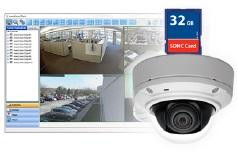Video Security Framework Configuration Guide
This guide has been created to help clients with those necessary choices to design a exacqvision video management system security framework effectively. The aide doesn't claim to be exhaustive, but instead, the objective is to give an instrument that starts a productive discussion between the client and the expert.
Video security has changed emphatically lately. The occasions of 9/11 have prompted sensational upgrades in the innovation. Combined with the development of PC advances, the business, once overwhelmed by "robber caution" organizations, is progressively upheld by the IT proficient.
Questions that are Pertinent to Pretty much Every Application:
What number of cameras will be required?
What camera is awesome for every application?
What sort of video the board framework is proper?
What number of Cameras will be Required?
The quantity of cameras will straightforwardly influence the characteristics of the video the board framework. The plan of video security frameworks is generally founded on checking key resources and gag focuses, for instance constructing passages.
Stifle focuses are an effective strategy for recording the development of people. Stifle focuses can incorporate passages, parking area carports, and doors to normal regions. Key resources incorporate things that are both of critical worth, and are likely to manhandle.
The quantity of cameras will straightforwardly influence the video the board plan. For these reasons, it is smarter to "cushion" the gauge, as it is typical for new necessities to develop.
What Camera Innovation is the Most ideal Decision for every Application?
Traditional versus Infrared (IR): The night-vision (IR) camera is as of now truly elegant. Incalculable bundles from the makers incorporate a bunch of IR cameras. There are applications that are best settled with this innovation, however it is as of now a typical slip-up for the IR camera to be utilized unpredictably. Most IR cameras have a scope of just 50-60 feet in night-vision mode. The reach is proportionate to how much IR enlightenment given by the camera, generally with IR LEDs. On the off chance that your field of view has to some degree a little light, a regular camera with auto-iris usefulness can offer prevalent execution.
Fixed versus PTZ: A PTZ camera can be remotely directed to get to an alternate field of view. PTZ cameras are ordinarily around 5X more costly than fixed cameras, and the video the board framework should incorporate help for the point of interaction. Most cameras utilized in video observation are fixed. A decent camera likewise is more reasonable for man-made consciousness capabilities (see video investigation underneath).
IP versus Simple: Most current video security frameworks are presently computerized. The distinction with the IP camera is that the video signal is digitized inside the camera. This makes it conceivable to connect with the camera with CAT5 link (network link) rather than the more costly coaxial link. Further developed IP cameras permit complex neighborhood handling of the exacqvision video recorder NVR distributor signal. Be that as it may, IP cameras are normally more costly than their simple cousins. It is feasible to piggyback IP cameras on existing organizations, however be cautioned: Video is a Transfer speed Hoard.
Focal point: The main choice is whether to utilize a manual iris or a programmed iris focal point. On the off chance that the camera is inside with steady lighting, a manual iris is fine (and more affordable); generally a programmed iris is emphatically suggested. Open air lighting force can normally shift by a component of 10,000. Central length is the other significant focal point choice. As the central length gets more modest, the field of view increments, yet makes for a more far off view. Customizable central length focal point can be changed.
For more Info:-

Comments
Post a Comment